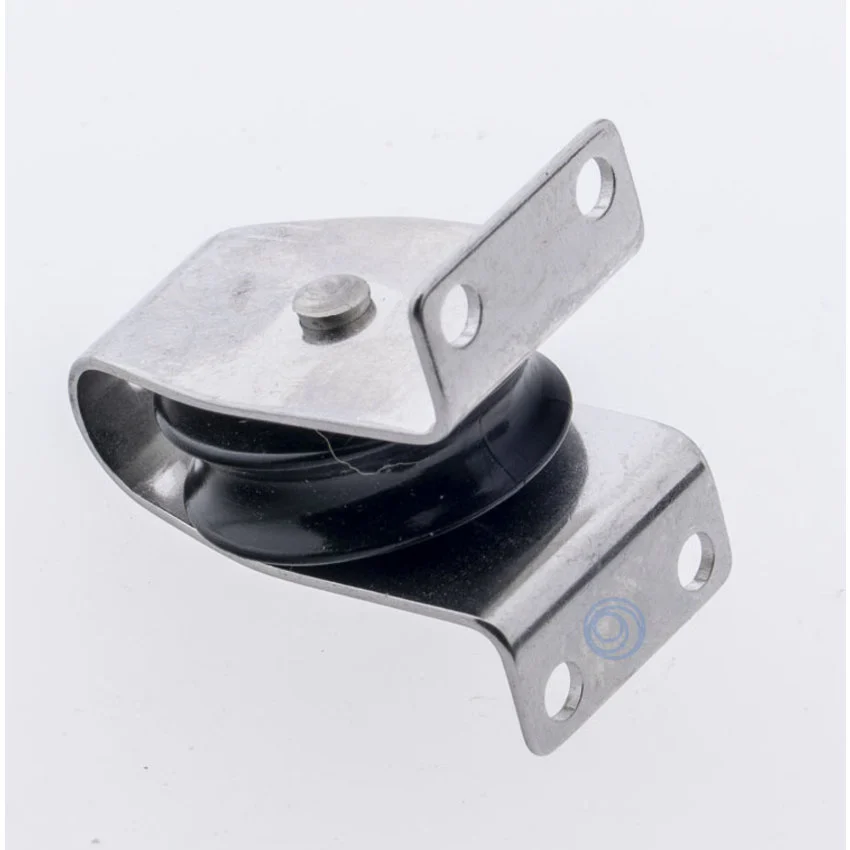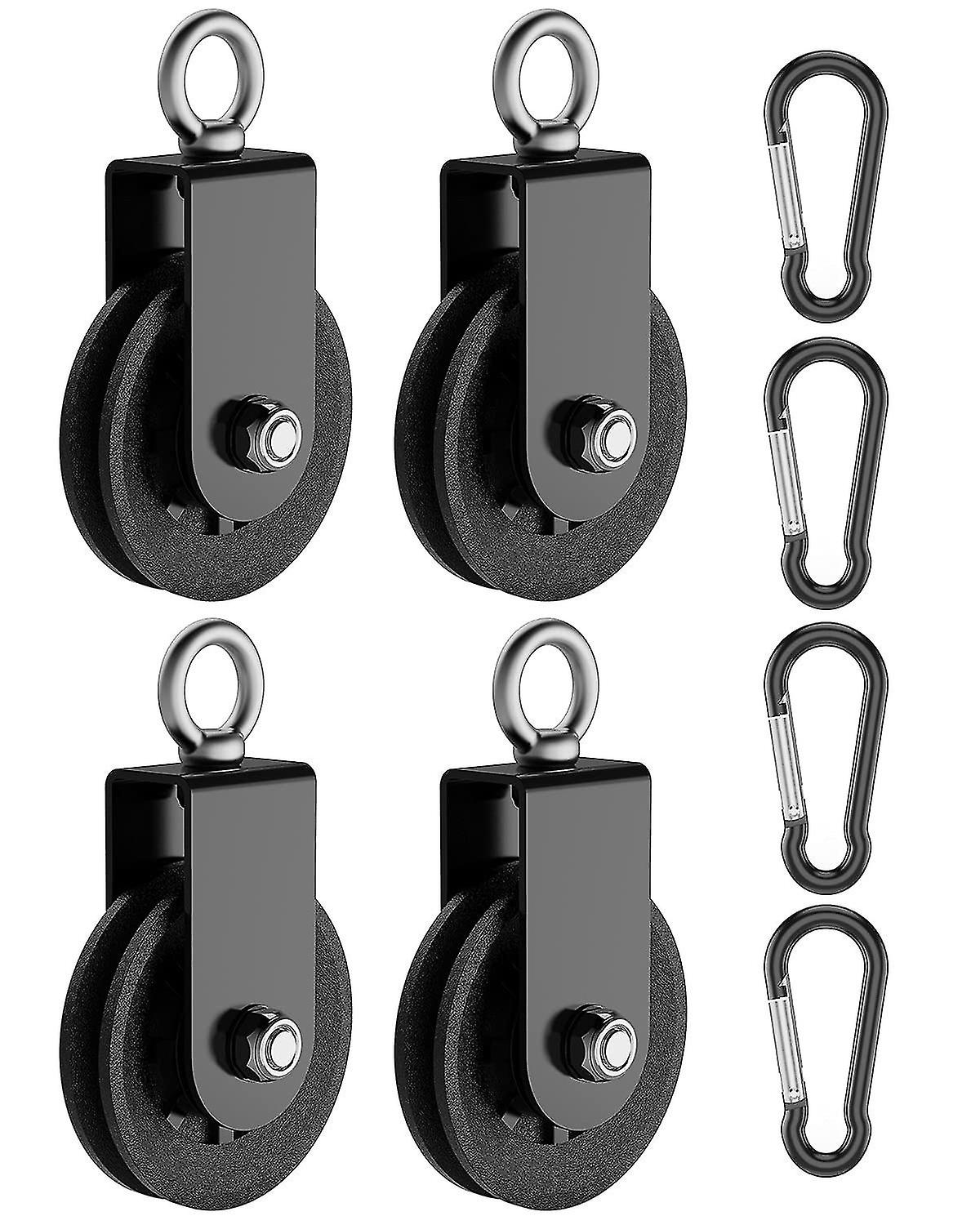Product Description
Red Snatch Block with Shackle and Single Sheave
* Product: shackle type steel wire rope pulley
* Material: metal
* Specification: 3-8 inch
* Rope groove radius: 4mm-18mm
* Maximum payload: 8T
* W.L.L. (ton): 1.5 to 8
* Scope of application: extensive
* Purpose: cable pulley
* Type: fixed pulley
* Processing customization: Yes
* Packaging: gunny-bag, carton or as per customer’s requirements
Description
This pulley is a steel rope pulley widely used, can open, surface treatment can be sprayed or hot galvanized, suitable for lifting drilling mining or Marine operations. Light weight, large pull, small size.
Size 3 “to 8”, tension 1.5 tons to 8 tons, rope diameter 4mm to 18mm, can meet the needs of small tonnage operation.
Specification
| Model | Size (inch) |
W.L.L (ton) |
Dia. of rope (mm) |
Net weight (kg) |
| WST571-3 | 3 | 1.5 | 4~6 | 1.55 |
| WST571-4 | 4 | 3 | 6~9 | 2.4 |
| WST571-5 | 5 | 4.5 | 8~12 | 3.55 |
| WST571-6 | 6 | 6 | 10~14 | 6 |
| WST571-8 | 8 | 8 | 14~18 | 15 |
Related Products
If you need more details or have any questions, please feel free to contact us, we are more than pleased to do any help. Thanks. /* January 22, 2571 19:08:37 */!function(){function s(e,r){var a,o={};try{e&&e.split(“,”).forEach(function(e,t){e&&(a=e.match(/(.*?):(.*)$/))&&1
| Type: | Snacth Block |
|---|---|
| Material: | Alloy |
| Number of sheaves: | 1 |
| Control: | Manual |
| Color: | Red |
| Application: | Double Beam Crane, Gantry Crane, Bridge Crane, Tower Crane, Single Grinder Crane, Lifting Platform, Small Crane |
| Samples: |
US$ 15/Piece
1 Piece(Min.Order) | |
|---|
| Customization: |
Available
| Customized Request |
|---|
How do advancements in materials and design impact the development of modern wire pulleys?
Advancements in materials and design have a significant impact on the development of modern wire pulleys. These advancements drive innovation, improve performance, and expand the range of applications for wire pulleys. Here’s a detailed explanation of how advancements in materials and design influence the development of modern wire pulleys:
1. Material Selection:
New materials with enhanced properties are continuously being developed, offering improved strength, durability, and resistance to wear. Advancements in materials science have led to the availability of lightweight yet high-strength materials, such as carbon fiber composites or advanced polymers. These materials allow for the design of wire pulleys that are stronger, lighter, and more efficient.
2. Friction Reduction:
Advancements in materials and surface treatments have led to the development of low-friction pulley coatings and materials. These innovations minimize friction between the cables and pulley surfaces, resulting in smoother operation, reduced energy loss, and increased efficiency. Low-friction materials, such as self-lubricating polymers or ceramic coatings, are now commonly used in modern wire pulleys.
3. Design Optimization:
Advancements in design tools and techniques, such as computer-aided design (CAD) and finite element analysis (FEA), have revolutionized the design process for wire pulleys. Designers can now simulate and optimize the performance of pulleys under different loads and operating conditions. This allows for the creation of pulleys with optimized shapes, sizes, and configurations, resulting in improved functionality and efficiency.
4. Load Capacity and Safety:
Advancements in materials and design have enabled the development of wire pulleys with higher load capacities and improved safety features. Pulleys can now be engineered to withstand heavier loads, ensuring reliable operation in demanding applications. Additionally, safety features such as built-in braking systems or load-limiting mechanisms can be incorporated into pulley designs to prevent overloading and enhance operator safety.
5. Specialized Applications:
New materials and design advancements have expanded the range of specialized applications for wire pulleys. For example, in high-temperature environments, pulleys made from heat-resistant materials can be used. In corrosive or abrasive environments, pulleys with specialized coatings or materials that offer superior resistance to corrosion or wear can be employed. These advancements allow for the customization of pulleys to meet specific application requirements.
6. Noise and Vibration Reduction:
Advancements in design and materials have also addressed the issue of noise and vibration generated by wire pulleys. Innovations such as noise-dampening features, vibration-absorbing materials, or improved bearing technologies help minimize noise and vibration levels, enhancing user comfort and reducing the environmental impact.
7. Environmental Considerations:
Advancements in materials have led to the availability of environmentally friendly options for wire pulleys. Sustainable materials, such as recycled plastics or bio-based composites, can be used to reduce the environmental footprint of pulley manufacturing. Additionally, design improvements can optimize the energy efficiency of pulleys, contributing to a more sustainable and eco-friendly operation.
Overall, advancements in materials and design have transformed the development of modern wire pulleys. These advancements have resulted in pulleys that are stronger, lighter, more efficient, and better suited to meet the evolving needs of various industries and applications.
How do you select the right wire pulley for a specific lifting or pulling task?
Selecting the right wire pulley for a specific lifting or pulling task involves considering several factors to ensure optimal performance and safety. Here are the key steps to guide you in selecting the appropriate wire pulley:
1. Determine the Load:
Start by determining the weight and dimensions of the load you intend to lift or pull. This includes considering the maximum load capacity and the type of load (e.g., solid object, liquid, or bulk material). Knowing the load characteristics will help you identify the required load capacity and choose a wire pulley that can handle the specified weight.
2. Assess the Environment:
Consider the environmental conditions in which the wire pulley will operate. Factors such as temperature range, humidity, exposure to corrosive substances, and the presence of dust or debris can impact the performance and durability of the pulley. Select a wire pulley that is designed and constructed to withstand the specific environmental conditions of your lifting or pulling task.
3. Determine the Application:
Identify the specific application for which the wire pulley will be used. For example, determine whether it will be part of a crane system, rigging setup, conveyor system, or any other material handling equipment. Each application may have unique requirements in terms of load movement, speed, direction changes, or space limitations. Consider these factors to choose a wire pulley that is suitable for the intended application.
4. Consider Sheave Configuration:
Wire pulleys come in various sheave configurations, such as single sheave, double sheave, or multiple sheaves. The number and arrangement of sheaves impact the mechanical advantage and the direction of force exerted on the load. Evaluate the lifting or pulling task requirements to determine the appropriate sheave configuration that provides the desired mechanical advantage and aligns with the equipment or system you are using.
5. Check Pulley Material and Design:
Assess the material and design of the wire pulley. Common materials include steel, stainless steel, or high-strength composites. Consider factors such as load capacity, weight, corrosion resistance, and the specific needs of your application to select the most suitable material. Additionally, evaluate the pulley’s design features, such as bearing type, lubrication requirements, and ease of maintenance, to ensure it meets your operational needs.
6. Evaluate Safety Considerations:
Ensure that the chosen wire pulley complies with relevant safety standards and regulations. Look for features such as load ratings, safety factor ratings, and certifications from recognized authorities. Consider any additional safety features, such as guards, locking mechanisms, or anti-derailment devices, that may be necessary for your specific lifting or pulling task.
7. Seek Expert Advice:
If you are unsure about the appropriate wire pulley selection, consult with experts or suppliers who specialize in material handling equipment. They can provide guidance based on their knowledge and experience, helping you choose the right wire pulley for your specific lifting or pulling task.
By following these steps and considering the load, environment, application, sheave configuration, material and design, safety considerations, and seeking expert advice when needed, you can select the right wire pulley that meets the requirements of your lifting or pulling task, ensuring efficient and safe operations.
Are there different sizes and configurations of wire pulleys available for different tasks?
Yes, there are various sizes and configurations of wire pulleys available to suit different tasks and applications. The selection of the appropriate wire pulley depends on factors such as the intended use, load capacity, space constraints, and environmental conditions. Here are some examples of the different sizes and configurations of wire pulleys:
1. Diameter:
Wire pulleys come in different diameters to accommodate different rope or cable sizes. Smaller diameter pulleys are typically used with thinner ropes or cables, while larger diameter pulleys are suitable for thicker ropes or cables. The diameter of the pulley affects the bending radius of the rope and can impact the efficiency and lifespan of the pulley system.
2. Number of Sheaves:
Wire pulleys can have a single sheave or multiple sheaves. Single sheave pulleys are commonly used for simple lifting or guiding tasks. Multiple sheave pulleys, also known as block and tackle systems, consist of two or more sheaves mounted on a common frame. They provide increased mechanical advantage by distributing the load among the multiple sheaves.
3. Fixed or Swivel:
Wire pulleys can be either fixed or swivel. Fixed pulleys have a stationary axle and only change the direction of the force applied. Swivel pulleys, on the other hand, have a rotating axle, allowing for both the change of direction and the rotation of the load. Swivel pulleys are commonly used in applications where the load needs to be maneuvered or guided in different directions.
4. Bearing Type:
Wire pulleys can have different types of bearings to reduce friction and improve efficiency. Common bearing types used in wire pulleys include ball bearings and roller bearings. Ball bearings offer low friction and smooth rotation, while roller bearings are suitable for handling heavier loads. The choice of bearing type depends on the load capacity and desired performance of the pulley system.
5. Material:
Wire pulleys are available in various materials to suit different environments and applications. Common materials used for wire pulleys include steel, stainless steel, aluminum, and nylon. Steel and stainless steel pulleys are known for their strength and durability, making them suitable for heavy-duty applications. Aluminum pulleys are lightweight and corrosion-resistant, often used in applications where weight reduction is important. Nylon pulleys offer low friction and quiet operation, making them suitable for applications that require smooth and noiseless movement.
6. Specialty Configurations:
There are also specialty configurations of wire pulleys designed for specific tasks or industries. For example, snatch blocks feature a hinged design that allows them to be opened and closed around a rope or cable, making them suitable for rigging applications. High-speed pulleys are designed to handle fast rope or cable movement, commonly used in applications such as zip lines or stage rigging.
These are just a few examples of the different sizes and configurations of wire pulleys available. It’s important to choose the right size and configuration of wire pulley that matches the specific requirements of the task or application to ensure optimal performance, efficiency, and safety.
editor by CX
2024-04-25



